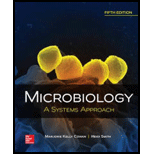
Concept explainers
Which of the following is not considered a microorganism?
- a. alga
- b. bacterium
- c. protozoan
- d. mushroom
Introduction:
The microscopic organisms occur as “uni-or multi-cellular” along with cluster of cells. There are various species of microorganisms covering almost the Earth. The microorganisms are divided into major types: “viruses”, “archaea”, “bacteria”, “fungi”, “protozoa”, and “algae”. The microorganisms are not generally seen from naked eyes.
Answer to Problem 1MCQ
Correct answer:
The microorganisms do not include mushroom.
Therefore, option (d) is correct.
Option (d) is given as “mushroom”.
Explanation of Solution
Justify reasons for the correct statement:
The fruiting body of a fungus that bears spores is termed as mushroom and is visible by naked eyes. This denies the definition of microorganism.
Hence, option (d) is correct.
Justify reasons for the incorrect statements:
Option (a) is given as “algae”.
The algal species are microscopic in nature. Hence, it is a wrong answer.
Option (b) is given as “bacterium”.
The bacterium is microscopic in nature. Hence, it is a wrong answer.
Option (c) is given as “protozoa”.
The protozoan species are microscopic in nature. Hence, it is a wrong answer.
Hence, options (a), (b), and (c) are incorrect.
The algae, protozoan, and bacteria are included in microorganism, while mushroom is not included in microorganism.
Want to see more full solutions like this?
Chapter 1 Solutions
Microbiology: A Systems Approach
- What part of an animal USUALLY do not have microbes? A. Teeth B.Genitalia C. Lungs D. Gastrointestinal tractarrow_forwardA bacterium has the following characteristics:∙ It adheres to the human intestinal lining using a feature that protects it from phagocytes, bacteriophages, and dehydration∙ It can survive being boiled∙ It contains no plasmids and relatively little peptidoglycanWhich of the following characteristics allows this bacterium to adhere to the intestinal lining? Group of answer choices A. fimbriae B. pili C. an endospore D. a flagellumarrow_forwardRecently, a microbe that is able to digest cellulose was discovered in a hot spring with an average temperature of 95°C. This microbe most likely belongs to which of the following groups? A. Archaea B. Proteobacteria C. Cyanobacteria D. Spirochetesarrow_forward
- You are looking at a white cottony growth on a culture medium. Microscopic examination reveals it is multicellular. You can conclude all of the following about this microorganism except that it: a. has cell walls b. has DNA enclosed in a nucleus c. is a bacterium d. absorbs organic nutrientsarrow_forwardDefine the following terms:a. endotoxinb. periplasmic spacec. biofilmd. slime layere. bacterial capsulearrow_forwardWhich of the following is NOT an example of a fungal spore? A. Zoospores B. Condia C. Endospore D. Basidiosporesarrow_forward
- Which among the following does nothave a cell wall?A. Euglena B. ParameciumC. Gonyaulax D. Mycoplasmaarrow_forwardWhat feature does Bacillus and Clostridium have in common that is not found among most other bacteria? a. Axial filamentb. Form Endosporesc. High concentration of lipids in cell wall d. Branching cellse. Obligate Intracellular Parasite All of the following pertain to the plague except... a. Rats are reservoirs b. Fleas serve as vectorsc. Outbreaks have never occurred in the U.S.d. Pneumonic type transmitted by aerosol droplets e. Produces swollen lymph nodes Which is not true of virus capsids?a. They surround and protect viral nucleic acidb. Always icosahedral in shapec. Remain outside of host bacterial cells while the nucleic acid is injected into the bacterial celld. Enters host animal cells together with the nucleic acid e. Made up of protein subunits called capsomeres All viruses have: a. DNA b. RNAc. Envelopesd. Glycoprotein spikes e. Host specificity Use the following to select the sequence of events during replication of DNA viruses in animal cells:1 = replication…arrow_forwardThe presence of what organism is sometimes used as an indicator that there is sewage present in the water? a. Escherichia coli or E. coli b. Pseudomonus c. Amoeba d. protozoaarrow_forward
- Glycerol Yeast extract agar (abbreviated GYA or GYEA) is used to promote the growth of A. Actinomycetes B. mold/fungi C. Bacteria D. yeast Is the answer is A or D?arrow_forwardChoose the combination of answers that most accurately completes the statement.Microbial control methods that kill are able to sterilize. a. viruses c. endospores b. the tubercle bacillus d. cystsarrow_forwardThe cells were first seen microscopically by A. Scheiden B. Schwann C. Leeuwenhock D. Robert Hookarrow_forward
 Human Anatomy & Physiology (11th Edition)BiologyISBN:9780134580999Author:Elaine N. Marieb, Katja N. HoehnPublisher:PEARSON
Human Anatomy & Physiology (11th Edition)BiologyISBN:9780134580999Author:Elaine N. Marieb, Katja N. HoehnPublisher:PEARSON Biology 2eBiologyISBN:9781947172517Author:Matthew Douglas, Jung Choi, Mary Ann ClarkPublisher:OpenStax
Biology 2eBiologyISBN:9781947172517Author:Matthew Douglas, Jung Choi, Mary Ann ClarkPublisher:OpenStax Anatomy & PhysiologyBiologyISBN:9781259398629Author:McKinley, Michael P., O'loughlin, Valerie Dean, Bidle, Theresa StouterPublisher:Mcgraw Hill Education,
Anatomy & PhysiologyBiologyISBN:9781259398629Author:McKinley, Michael P., O'loughlin, Valerie Dean, Bidle, Theresa StouterPublisher:Mcgraw Hill Education, Molecular Biology of the Cell (Sixth Edition)BiologyISBN:9780815344322Author:Bruce Alberts, Alexander D. Johnson, Julian Lewis, David Morgan, Martin Raff, Keith Roberts, Peter WalterPublisher:W. W. Norton & Company
Molecular Biology of the Cell (Sixth Edition)BiologyISBN:9780815344322Author:Bruce Alberts, Alexander D. Johnson, Julian Lewis, David Morgan, Martin Raff, Keith Roberts, Peter WalterPublisher:W. W. Norton & Company Laboratory Manual For Human Anatomy & PhysiologyBiologyISBN:9781260159363Author:Martin, Terry R., Prentice-craver, CynthiaPublisher:McGraw-Hill Publishing Co.
Laboratory Manual For Human Anatomy & PhysiologyBiologyISBN:9781260159363Author:Martin, Terry R., Prentice-craver, CynthiaPublisher:McGraw-Hill Publishing Co. Inquiry Into Life (16th Edition)BiologyISBN:9781260231700Author:Sylvia S. Mader, Michael WindelspechtPublisher:McGraw Hill Education
Inquiry Into Life (16th Edition)BiologyISBN:9781260231700Author:Sylvia S. Mader, Michael WindelspechtPublisher:McGraw Hill Education





